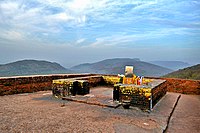Vulture Peak
| Gijjhakūṭa | |
|---|---|
| Vulture Peak or Eagle Peak | |
 Vulture Peak from above | |
| Highest point | |
| Coordinates | 25°00′06″N 85°26′47″E / 25.00167°N 85.44639°ECoordinates: 25°00′06″N 85°26′47″E / 25.00167°N 85.44639°E |
| Geography | |
 Gijjhakūṭa | |
| Parent range | Rajgir hills |
The Vulture Peak (Pali: Gijjhakūṭa, Sanskrit: Gṛdhrakūṭa), also known as the Holy Eagle Peak or Gādhrakūta, was the Buddha's favorite retreat in Rajagaha (now Rajgir/Rajagrih). It was the scene for many of his discourses. Rajgir is located in Bihar, India. It is so named because it resembles a sitting vulture with its wings folded.
In Buddhist literature[]
Vulture Peak Mountain is, by tradition, one of several sites frequented by the Buddha and his community of disciples for both training and retreat. Its location is frequently mentioned in Buddhist texts in the Pāli Canon of Theravada Buddhism[1][2] and in the Mahayana sutras as the place where the Buddha gave certain sermons. Among the sermons are the Heart Sutra, the Lotus Sutra and the Śūraṅgama Samādhi Sūtra as well as many prajnaparamita sutras. It is explicitly mentioned in the Lotus Sutra, chapter 16, as the Buddha's pure land:
And when the living have become faithful,
Honest and upright and gentle,
And wholeheartedly want to see the Buddha,
Even at the cost of their own lives,
Then, together with the assembly of monks
I appear on Holy Eagle Peak.
...
Such are my divine powers.
Throughout countless eons,
I have always lived on Holy Eagle Peak
And in various other places.
When the living witness the end of an eon,
When everything is consumed in a great fire,
This land of mine remains safe and tranquil,
Always filled with human and heavenly beings.[3]
Gallery[]

Monk in the hills around Vulture Peak

Meditation area

View from above

Vulture Peak

Buddhist assembly
References[]
Notes[]
- ^ "The Sona Sutta: About Sona". Archived from the original on 2020-03-31. Retrieved 2012-02-12.
- ^ "The Daruka-Khanda Sutta: The Woodpile". Archived from the original on 2011-12-28. Retrieved 2012-02-12.
- ^ Reeves 2008, pp. 296–297.
Bibliography[]
- Reeves, Gene (2008). The Lotus Sutra: A Contemporary Translation of a Buddhist Classic. Wisdom Publications. pp. 296–297. ISBN 978-0-86171-571-8.
External links[]
| Wikimedia Commons has media related to Vulture Peak. |
- Vulture Peak on Dhamma Wiki
- elevation on buddhadhyana
- Pāli Canon
- Mountains of Bihar
- Nalanda district
- Buddhist sites in Bihar





